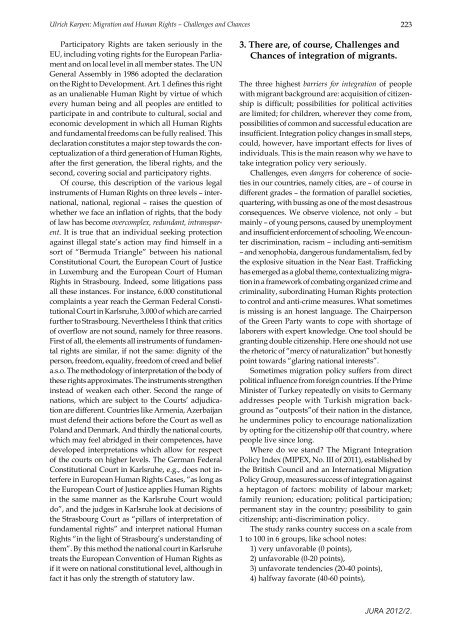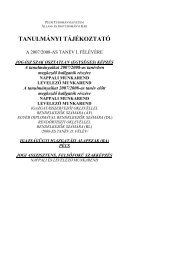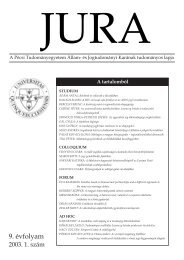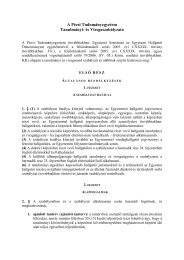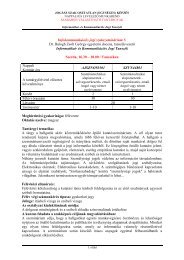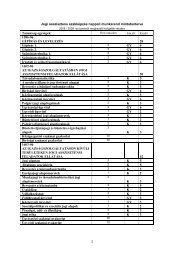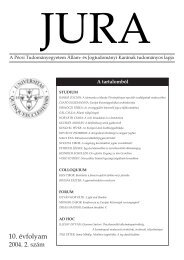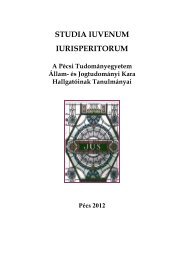2012. évi 2. szám - Jura - Pécsi Tudományegyetem
2012. évi 2. szám - Jura - Pécsi Tudományegyetem
2012. évi 2. szám - Jura - Pécsi Tudományegyetem
- TAGS
- jura
You also want an ePaper? Increase the reach of your titles
YUMPU automatically turns print PDFs into web optimized ePapers that Google loves.
Ulrich Karpen: Migration and Human Rights – Challenges and Chances223Participatory Rights are taken seriously in theEU, including voting rights for the European Parliamentand on local level in all member states. The UNGeneral Assembly in 1986 adopted the declarationon the Right to Development. Art. 1 defines this rightas an unalienable Human Right by virtue of whichevery human being and all peoples are entitled toparticipate in and contribute to cultural, social andeconomic development in which all Human Rightsand fundamental freedoms can be fully realised. Thisdeclaration constitutes a major step towards the conceptualizationof a third generation of Human Rights,after the first generation, the liberal rights, and thesecond, covering social and participatory rights.Of course, this description of the various legalinstruments of Human Rights on three levels – international,national, regional – raises the question ofwhether we face an inflation of rights, that the bodyof law has become overcomplex, redundant, intransparent.It is true that an individual seeking protectionagainst illegal state’s action may find himself in asort of “Bermuda Triangle” between his nationalConstitutional Court, the European Court of Justicein Luxemburg and the European Court of HumanRights in Strasbourg. Indeed, some litigations passall these instances. For instance, 6.000 constitutionalcomplaints a year reach the German Federal ConstitutionalCourt in Karlsruhe, 3.000 of which are carriedfurther to Strasbourg. Nevertheless I think that criticsof overflow are not sound, namely for three reasons.First of all, the elements all instruments of fundamentalrights are similar, if not the same: dignity of theperson, freedom, equality, freedom of creed and beliefa.s.o. The methodology of interpretation of the body ofthese rights approximates. The instruments strengtheninstead of weaken each other. Second the range ofnations, which are subject to the Courts’ adjudicationare different. Countries like Armenia, Azerbaijanmust defend their actions before the Court as well asPoland and Denmark. And thirdly the national courts,which may feel abridged in their competences, havedeveloped interpretations which allow for respectof the courts on higher levels. The German FederalConstitutional Court in Karlsruhe, e.g., does not interferein European Human Rights Cases, “as long asthe European Court of Justice applies Human Rightsin the same manner as the Karlsruhe Court woulddo”, and the judges in Karlsruhe look at decisions ofthe Strasbourg Court as “pillars of interpretation offundamental rights” and interpret national HumanRights “in the light of Strasbourg’s understanding ofthem”. By this method the national court in Karlsruhetreats the European Convention of Human Rights asif it were on national constitutional level, although infact it has only the strength of statutory law.3. There are, of course, Challenges andChances of integration of migrants.The three highest barriers for integration of peoplewith migrant background are: acquisition of citizenshipis difficult; possibilities for political activitiesare limited; for children, wherever they come from,possibilities of common and successful education areinsufficient. Integration policy changes in small steps,could, however, have important effects for lives ofindividuals. This is the main reason why we have totake integration policy very seriously.Challenges, even dangers for coherence of societiesin our countries, namely cities, are – of course indifferent grades – the formation of parallel societies,quartering, with bussing as one of the most desastrousconsequences. We observe violence, not only – butmainly – of young persons, caused by unemploymentand insufficient enforcement of schooling. We encounterdiscrimination, racism – including anti-semitism– and xenophobia, dangerous fundamentalism, fed bythe explosive situation in the Near East. Traffickinghas emerged as a global theme, contextualizing migrationin a framework of combating organized crime andcriminality, subordinating Human Rights protectionto control and anti-crime measures. What sometimesis missing is an honest language. The Chairpersonof the Green Party wants to cope with shortage oflaborers with expert knowledge. One tool should begranting double citizenship. Here one should not usethe rhetoric of “mercy of naturalization” but honestlypoint towards “glaring national interests”.Sometimes migration policy suffers from directpolitical influence from foreign countries. If the PrimeMinister of Turkey repeatedly on visits to Germanyaddresses people with Turkish migration backgroundas “outposts”of their nation in the distance,he undermines policy to encourage nationalizationby opting for the citizenship o0f that country, wherepeople live since long.Where do we stand? The Migrant IntegrationPolicy Index (MIPEX, No. III of 2011), established bythe British Council and an International MigrationPolicy Group, measures success of integration againsta heptagon of factors: mobility of labour market;family reunion; education; political participation;permanent stay in the country; possibility to gaincitizenship; anti-discrimination policy.The study ranks country success on a scale from1 to 100 in 6 groups, like school notes:1) very unfavorable (0 points),2) unfavorable (0-20 points),3) unfavorate tendencies (20-40 points),4) halfway favorate (40-60 points),JURA 2012/<strong>2.</strong>


